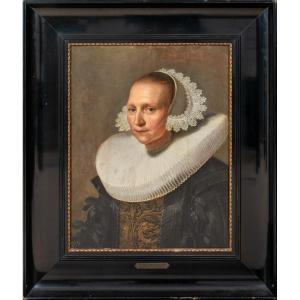Relined canvas measuring 86.5 cm by 76.5 cm
Old frame measuring 100 cm by 90 cm.
This superb painting is a studio version of the Master. The original can be admired in Kassel, Germany: (https://commons.wikimedia.org/wiki/File:Hyacinthe_Rigaud_und_Joseph_Parrocel_-_Bildnis_des_Henri_Louis_de_la_Tour_d%C2%B4Auvergne,_Comte_d%C2%B4Evreux,_250905.jpg
The Count of Evreux, Louis-Henri de La Tour d'Auvergne (1679-1753)
Louis-Henri de La Tour d'Auvergne was the son of the Duke of Bouillon and Governor of Auvergne Godefroy-Maurice de La Tour d'Auvergne and Marie-Anne Mancini, niece of Mazarin. He was also a great-nephew of Marshal Turenne. His military career began in 1691. He was appointed ensign in the King's Regiment during the siege of Mons. In 1698, he was colonel of the Blaisois regiment and gradually rose through the ranks. Brigadier on January 29, 1702, he was promoted to the rank of field marshal on October 26, 1704. In 1707, he married Marie-Anne Crozat (1696-1729), aged 11, daughter of Antoine Crozat, a very wealthy banker in Paris. This brought him a considerable dowry of 2 million livres. On June 19, 1708, he was made lieutenant general of the king's armies. In 1716, he was appointed governor of Poitou, then in 1719, of Île-de-France. From 1716 to 1718, he was a member of the War Council, responsible for the cavalry. Between 1718 and 1722, he had a new private mansion built in Paris, which became his main residence. This hotel in Évreux is today better known as the Elysée Palace. He died there on August 3, 1753. He is buried with his wife in the church of Saint Paul Saint Louis, in the 4th arrondissement of Paris, under the chapel of Saint-Jérôme. His coat of arms appears on the stained glass window.
Hyacinthe Rigaud (1659-1743)
Hyacinthe Rigaud,born in Perpignan on July 18, 1659 and died in Paris on December 29, 1743, is a French painter, specialized in portraiture. Born in the former province of Catalonia (his real name in Catalan was Jacint Rigau-Ros i Serra), he spent most of his career in Paris. Noticed by Louis XIV, whom he painted in a now famous portrait, Hyacinthe Rigaud became highly courted by all the nobility of France and Europe, while maintaining a very loyal regional and local clientele. The young Hyacinthe Rigaud perfected his skills with Antoine Ranc (in the company of Jean Ranc, Antoine's son) in Montpellier in the 1671s, before moving to Lyon four years later. It was in these two cities that he became familiar with Flemish, Dutch and Italian painting, that of Rubens, Van Dyck, Rembrandt and Titian, whose works he would later collect. Arriving in Paris in 1681, he won the Prix de Rome in 1682, but did not make the trip to Rome, on the advice of Charles Le Brun. Received into the Royal Academy of Painting and Sculpture in 1700, he rose through the ranks of this institution until his resignation in 1735. According to the French art writer Louis Hourticq, "Rigaud, in dying, leaves a gallery of great figures with whom our imagination now populates the Hall of Mirrors; Rigaud is necessary to the glory of Louis XIV and he participates in this influence of a reign whose majesty he has fixed. Rigaud's paintings now populate the greatest museums in the world. His work is considerable, more than 1500 known to date. The artist was able to count on a workshop rich in great names in painting including Jean Ranc, Marc Nattier, Jean le Gros, Robert de Tournière...and many others (more than thirty during the entire period).


























 Le Magazine de PROANTIC
Le Magazine de PROANTIC TRÉSORS Magazine
TRÉSORS Magazine Rivista Artiquariato
Rivista Artiquariato
